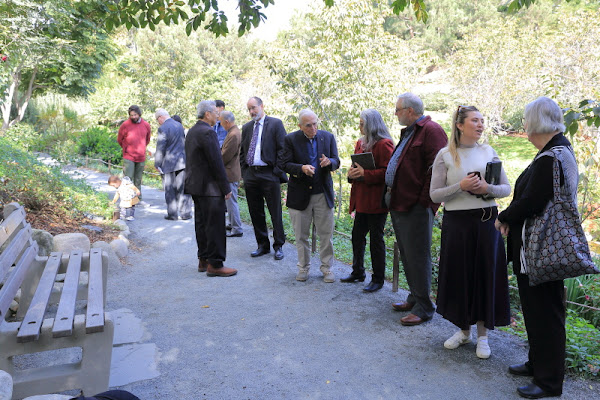The following is a speech given by Kirk Imamura at the Bench Dedication Ceremony held at the Japanese Friendship Garden & Museum to honor his parents, Rio and Tamiko Imamura, on November 16, 2024.
Friends and colleagues of Rio & Tamiko Imamura. Thank you for being here to celebrate with our families the unveiling of the bench and the plaque in honor of my parents in this peaceful setting.
But first, I would like to thank you for all your well wishes, your letters of support and flowers when my father passed away last July at the age of 93. I can say that my mother very much appreciated hearing from you and she sends her sincere thanks.
Now, I will say upfront that I have never attended any Toastmaster meetings, and I might take up more than three minutes so bear with me.
Let me start with a quote.
“The true meaning of life is to plant trees, under whose shade you do not expect to sit.”
— Nelson Henderson
Beautiful & very fitting, isn’t it? I might modify the last part to, “under whose shade you do not expect to sit or find a bench to sit on.” We will walk over to that bench today.
As I contemplate my own impending retirement, I ask myself, what did I achieve from working all those hours? Did I make a difference? What is my legacy? Ah, the dreaded “L” word. I was lucky enough to spend 16 years in the music industry, interacting with prominent artists. To some of them, legacy was an all-important idea, mostly driven by ego.
Looking back at my own work, I was not seeing a lot that had staying power. I spent a large part of my career in the technology sector, and the march of obsolescence kept pace with Moore’s Law. I worked on products like the Betamax VCR, the television picture tube and the 3.5” floppy disk drives. The younger folks growing up today would not know what any of these things are without looking them up on the internet.
Reflecting upon my father’s life, I realized a few very important lessons. Number 1: Yes, nothing lasts forever, but there are some things that last longer than others. Just look around at this beautiful Japanese Garden. This place opened to the public in 1991 and it continues to be enjoyed by over 300,000 visitors every year. My father was lucky enough to be on the team that brought the very idea of this garden to life, along with many of you in the audience today, and it was made possible with the backing of the late, esteemed Dr. Inamori. The Minato Gakuen, the Japanese language school, is another great example. He worked with many of you here and the school is thriving today. My father was lucky enough to be part of many things bigger than himself.
But it did not end there. After retiring from Kyocera, my father still had the drive to build more. He was one of the founders, along with my mother, in establishing the Kitakyushu English speaking Toastmaster chapter. The chapter is very active with over 50 members and growing. Which leads me to lesson Number 2: you can still achieve great things, even after retirement.
None of these things can be achieved alone. You need help from lots of other people who share the same vision, but first you must find these like-minded people. My father had an uncanny ability to build bridges and connect with people from all over the world through the Toastmasters network. He was not shy about going up to people and starting up a conversation and was always interested in learning about them and their culture. He went beyond that. He kept in touch with almost everyone he met. His address books (plural) were like several phone books and the drafts of his correspondences literally filled his study, and we can attest to that.
Lesson #3, the final lesson was: legacy is not about products or things, stupid. It is about people and institutions, places where people can gather to learn, to enjoy, to appreciate and to socialize, places that have the potential to affect & impact multiple generations of people past, present & future – like this garden and the Minato Gakuen. That is certainly a legacy one can be proud of. My father was able to share in this legacy and he continues to be a source of inspiration for me, especially at the stage of life I am at.
I do want to acknowledge that all the things that my father was involved with could not have been possible without the support and understanding of my mother. She was the enabler, the one who held down the fort, and the one who had to primarily deal with my sister and me. She was also an active participant, getting involved behind the scenes, working with other wives, helping people get acclimated. She was no slouch. She was the Sergeant of Arms for the Toastmaster chapter she helped establish for many years. She achieved Distinguished Toastmaster (DTM) status and became a good speech giver in her own right.
If we are talking legacy, one cannot go without mentioning family. My parents became proud grandparents recently. I would like to introduce the family members who are here today.
So, in summary, I would like to leave you with another quote, this one by Maya Angelou.
“Your legacy is every life you’ve touched.”
That is a legacy worth striving for.
I would like to thank the Board of Directors, the Executive Director and CEO, and staff members of the Japanese Friendship Garden & Museum for maintaining & keeping this magnificent place going. I want to give a special heartfelt thanks to Mike Kawamura for organizing and hosting this event.
Thank you all for coming.












